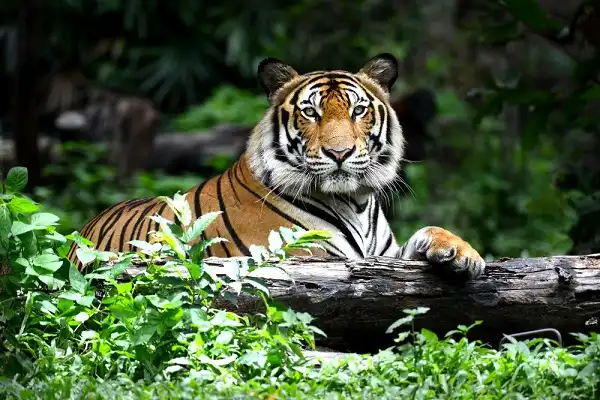Have you ever heard of the majestic and powerful Bengal Tiger? This remarkable creature has been an inspiration to people for centuries, with its stripes brightening up various artworks such as paintings, tapestries, and carvings throughout history. But beyond its beauty lies a fierce hunter on the prowl in many parts of Asia. And since it’s listed as endangered on the Red List of Threatened Species, we should make sure that this treasure doesn’t become extinct due to human poaching or habitat destruction. Stay with us until the end of this blog post to discover all there is to know about the Bengal tiger!

Bengal Tiger Description
The Bengal Tiger, also known as the Royal Bengal Tiger, is a subspecies of tiger native to South and Southeast Asia. The fur of a Bengal Tiger ranges from yellow to orange-brown with stripes varying in color from black to dark brown. Its unique pattern of stripes helps it blend into its environment, allowing it to sneak up on its prey undetected. They also have large paws with semi-retractable claws which provide them with excellent traction in water and on land. Additionally, their whiskers help them navigate in darkness and detect movement through vibrations in the air.
Bengal Tiger Habitat
The Bengal Tiger is a highly adaptable species and can inhabit various types of habitats such as tropical rainforests, temperate Himalayan broadleaf forests, dry deciduous forests, and mangrove swamps. Their preferred habitat is dense vegetation that provides cover while hunting but they can also be found in grasslands, savannas, and even deserts. The Bengal Tiger prefers to stick near rivers or streams where water is available for drinking and cooling off during the hot summer months. Due to decreasing amounts of natural prey due to human activities, Bengal Tigers have been forced to expand their range into other ecosystems outside of their traditional habitats. As a result, there has been an increase in cases of conflict between tigers and humans such as livestock depredation by the tigers. This further contributes to the decline in Bengal Tiger populations in certain areas. Nepal, India, and Bangladesh are currently home to most of the remaining wild Bengal Tigers with additional populations being found in Bhutan, Myanmar, and China. In India alone, the tiger population is estimated at around 2226 individuals as per government data from 2020. Conservation efforts have led to a slow but steady increase in this number over recent years which is encouraging news for those who want to keep this majestic species alive for future generations.
Bengal Tiger Diet
The Bengal Tiger is a powerful and skilled hunter, capable of catching both small and large prey. They primarily hunt medium-sized mammals such as deer, wild pigs, antelopes, and water buffalo but they also feed on birds, reptiles, fish, and eggs. With their sharp senses of smell and hearing, they can track their quarry with ease even when it is hidden behind thick vegetation or considerable distances away. Bengal Tigers typically hunt almost exclusively at night using stalk-and-ambush techniques where they patiently wait for their prey before pouncing with lightning speed. Once the target has been caught they may choke or suffocate the animal with their powerful jaws before biting into its flesh to finish it off quickly and humanely. In some cases, Bengal Tigers have been known to drag their prey up to several kilometers before consuming it.

Bengal Tiger Size
The Bengal Tiger is one of the largest cats in the world, with males measuring up to 3.7 m (12 ft) in length from nose to tail and weighing up to 300 kg (660 lb). Females tend to be slightly smaller, measuring up to 2.6 m (8.5 ft) in length and weighing up to 160 kg (350 lb). This powerful creature has a muscular body that is built for strength and agility making it a formidable hunter. The striped pattern on its fur helps it blend into its environment and can vary greatly in color; from pale orange-brown with stripes ranging from dark brown to black. Its ears are round with white patches on the back while its forehead is crowned by a ‘tiger stripe’ pattern, a unique feature that sets it apart from other tigers. It also has long whiskers which act as tactile sensors allowing it to detect movement through vibrations in the air even when visibility is low.
Bengal Tiger Lifespan
The average lifespan of a Bengal Tiger in the wild is around 10-15 years. However, tigers living in captivity can live up to 20 years or longer. In addition, research has found that males tend to have a shorter lifespan than females due to the extra energy they expend in order to claim and defend their territory. Due to heavy poaching and human encroachment on their habitats, the lifespan of captive Bengal Tigers is often shorter than those in the wild as they are more vulnerable to disease and other threats such as predation from other animals. They may also suffer from malnutrition if not provided with a balanced diet. Furthermore, these majestic creatures face additional challenges such as being hit by vehicles on roads or being poisoned by poachers which can drastically reduce their life expectancy.
Bengal Tiger Behavior
The Bengal Tiger is a solitary and highly territorial animal, fiercely protecting its home range from intrusions of other tigers. They communicate with each other through a variety of vocalizations and scent marks, including infrasonic calls which can be heard up to two kilometers away. Bengal Tigers are most active at night or during the early morning hours when they look for food and mark their territories by scratching trees, urinating on rocks, or leaving droppings containing their signature scent. During the day they usually rest in dense vegetation or deep pools of water where they remain unseen and unbothered by nearby predators such as leopards or wolves. Though often thought of as solitary animals, Bengal Tigers will sometimes form social relationships with others of their species. Females may form temporary bonds with other females while taking care of offspring or defending their territories against intruders; while males may form coalitions with other males to take over new areas and establish dominance over large territories.

Bengal Tiger Speed
The Bengal Tiger is one of the fastest land animals on earth, able to reach speeds of up to 80 km/h (50 mph). This extraordinary speed enables it to quickly catch its prey and flee from predators. It is also capable of bursts of acceleration which can help it close in on potential meals in a matter of seconds. This incredible speed is possible due to the tiger’s muscular body and powerful limbs. Its hind legs contain large muscles that provide it with exceptional power and agility when running and leaping. In addition, its long tail acts like a rudder, helping it maneuver through dense vegetation or water with ease. The Bengal Tiger’s top speed however is not sustainable for long periods of time as their large size puts a strain on their bodies. They can maintain this speed for short distances but over longer distances, they tend to reduce their pace to conserve energy. This makes them excellent sprinters but less efficient at sustained running or chasing down prey that runs for longer distances.
Bengal Tiger Reproduction
The Bengal Tiger is an apex predator and is capable of reproducing, with female tigers reaching sexual maturity at the age of three or four years. The mating season for the tiger usually takes place in winter and spring, which is when most of the cubs are born. Female tigers will typically give birth to litters of 2 to 4 cubs at a time, and each litter can take up to 2 months to develop. Tigers exhibit a unique pattern of parental care, often referred to as ‘maternal investment’. This involves the females taking on all responsibilities such as finding food and shelter for their cubs and teaching them how to hunt, while males rarely take part in parenting duties. After weaning off their mother’s milk, the cubs will stay with their mother until they are about 18 months old before venturing out on their own.
Bengal Tiger Hunting
Bengal Tigers are expert hunters, using a combination of stealth and speed to successfully capture their prey. They typically hunt alone and rely on their powerful senses – sight, smell, and hearing – to locate food. Their night vision is particularly well-developed, allowing them to see up to three times better than humans at night. This enhanced night vision helps them spot potential prey in the darkness. When hunting, Bengal Tigers will often use ambush tactics to surprise their prey rather than chase them for long distances. They may also stalk an animal from a distance before making the final strike with lightning-fast reflexes. Once they’ve made the kill, the tiger uses its sharp retractable claws and razor-sharp teeth to rip open the carcass and consume its meal.

Conclusion
The Bengal Tiger is one of the most beloved animals on earth and the national animal of India. It is a powerful predator with impressive speed, stealth, and agility that allows it to successfully capture its prey. This majestic creature also has incredible intelligence as well as loyalty which has been captured in various folk tales throughout South Asia for generations now. Their playful nature further endears them to many people around the world! However, despite their prowess as predators and their strong social bonds, Bengal Tigers are facing a multitude of challenges due primarily to poaching and habitat destruction. Thankfully there have been several conservation efforts undertaken to help protect this species from extinction and ensure they can continue living out their lives as apex predators in peace!
Frequently Asked Question

